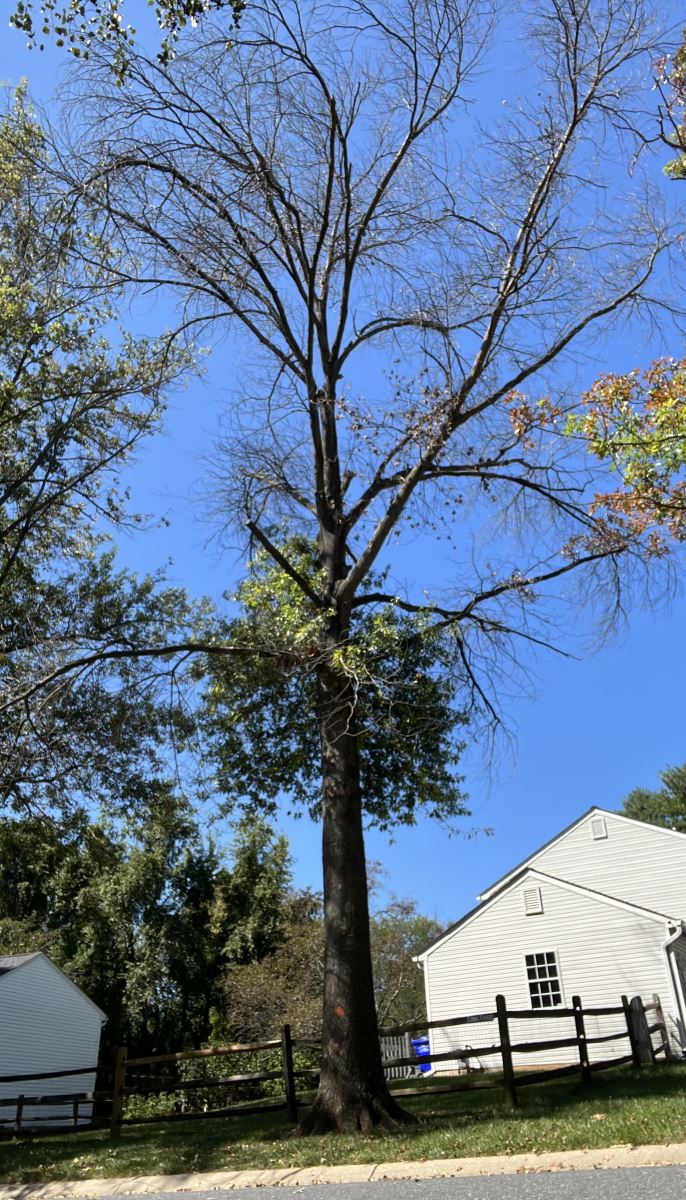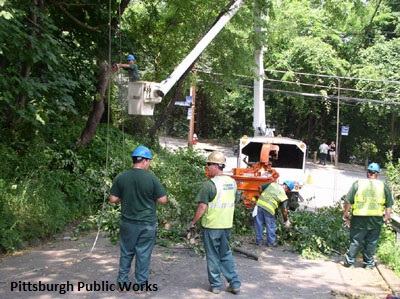Tree Concerns and Removal
 Trees are the answer to many of the issues we face in an urban environment. Trees needs care and maintenance throughout their lives, but more as they mature. At times, it is appropriate to remove trees. Removing trees, even small ones, is very dangerous work. Therefore, it is important, and required by law, to hire an expert.
Trees are the answer to many of the issues we face in an urban environment. Trees needs care and maintenance throughout their lives, but more as they mature. At times, it is appropriate to remove trees. Removing trees, even small ones, is very dangerous work. Therefore, it is important, and required by law, to hire an expert.
Why is it important to hire an expert just to remove a tree? In Maryland, anyone being paid to work on, evaluate, give advice about trees must be licensed through the Maryland Department of Natural Resources Forest Service. A Maryland licensed tree expert is required to have training and follow safety procedures. Further, in the event that something goes wrong and property is damaged, a licensed tree expert is required to be appropriately insured and bonded. Maryland offers tips on choosing a licensed tree expert (PDF) to remove or trim your trees.
Do I Need a Permit to Remove My Tree?
If you answer yes to any of these questions, you may need a permit to remove an individual tree:
Is the tree in the right-of-way of any roads?
If yes, contact the Maryland Department of Natural Resources Forest Service to obtain a " Roadside Tree Project Permit". A permit is required from Maryland for planting, pruning, or removing a tree from ANY right-of-way. This includes streets and roads maintained by villages, towns, cities, the County, and the State.
Is the tree in the right-of-way of any road maintained by Montgomery County?
If yes, contact the Montgomery County Department of Permitting Services (DPS) to obtain a permit. Anyone who applies for a building permit, a sediment control permit, or a permit to work in a right-of-way maintained by Montgomery County is required to comply with the Roadside Tree Law. This permit is in addition to a permit from the Maryland Forest Service. Both permits are needed to work on trees in rights-of-way maintained by Montgomery County.
Are you disturbing more than 5,000 square feet of canopy or soil?
If yes, contact DPS for a sediment control permit. Check with DPS about other requirements for obtaining a sediment control permit, including building a home or business.
What about the Canopy Conservation Law in Montgomery County?
Anyone who is required to obtain a sediment control permit from Montgomery County is required to comply with the Tree Canopy Law.
Is the tree in a conservation easement?
If the tree is in a conservation easement, then contact your Planning Team within the Montgomery Planning Department for permission to remove the trees.
Is the tree on a historic site?
If the tree is in an historic area designated by the Montgomery Planning Department, then contact them to determine if a Historic Area Work Permit is required to remove the tree.
Are you in an incorporated city, town, or village?
If yes, contact your city, town, or village officials directly before performing any tree work. Within Montgomery County, there are many incorporated cities, towns, and villages. Each of these may have their own codes and regulations regarding street trees and trees on private property.
Do you live in a homeowner’s association or civic association with rules or guidelines?
If yes, check with your home owner’s association or civic association directly.
Is the tree hazardous?
In all cases, if a tree is found to be hazardous by a Maryland licensed tree expert (LTE) or certified arborist, the hazard may be removed as soon as possible by an LTE. The LTE must notify, in writing, the appropriate agency within 14 days. Any work beyond what is needed to remove the hazardous condition must be completed with necessary permits. For example, a hazardous branch on a tree may be removed by an LTE without prior permission but all non-hazardous sections of the tree must remain until required permits are obtained.
Hiring a Tree Expert
Why is it important to hire an expert to work on your tree?
In Maryland, anyone being paid to work on, evaluate, or give advice about trees is required by law to be a Licensed Tree Expert. To verify a license, visit the Maryland Forest Service or call 410-260-8531.
A licensed tree expert is required to be well-trained and experienced in how to care for trees, how to trim or remove trees, how to recognize hazardous trees, how to plant trees, etc. all in such a way as to be safe and follow laws. Further, a Maryland Licensed Tree Expert is required to be appropriately insured and bonded.

5 Tips on Hiring A Maryland Licesned Tree Expert
Maryland offers tips on choosing a licensed tree expert (PDF) to remove or trim your trees.
- Ask to see their Tree Expert license. Any Licensed Tree Expert will carry a card that contains their expert number and verifies their status as being licensed. To verify it, visit Maryland Forest Service or call 410-260-8531.
- Ask for proof of insurance. A Licensed Tree Expert will have insurance coverage for personal and property damage, as well as worker’s compensation insurance.
- Ask for references. Find out where the company or person has done work similar to the work you are requesting. Don’t hesitate to check references or visit other sites where the company or individual has done tree work.
- Get an estimate in writing. Maryland Licensed Tree Experts are required to enter into a written contract with each client. Be sure to read the contract carefully and make sure it includes information on when the work will be started and completed, who is responsible for clean-up, and the total price and an hourly rate if more work needs to be done.
- Be wary of individuals who solicit business door-to-door. While these individuals may appear to be offering lower costs for tree care services, be assured it’s no bargain. A person soliciting business door-to door will often give a cell phone number and no other means of contact (this makes it very difficult to find them should a problem arise). All Maryland Licensed Tree Experts must maintain up-to-date contact information with the State.
Are there Other Certifications for Tree Experts?
Yes. In addition to the Maryland license required by law, there are several organizations who certify arborists and others who require certain qualifications for membership. Many arborists have more than one qualification. Here are some well-known tree-care organizations:
- International Society of Arboriculture (ISA)
- Mid-Atlantic Chapter, International Society of Arboriculture (MAC-ISA)
- American Society of Consulting Arborists (ASCA)
- Maryland Arborist Association (MAA)
- Tree Care Industry Association (TCIA)
Trees and the Law: Neighbor-related Disputes
Maryland has adopted the “Massachusetts Self-Help Rule” that says you must assume responsibility for the care and preservation of your own property. This means that you can cut branches that hang over onto your property. However, you may not destroy the tree in the process, nor can you cut the tree down.
Also, you must stop at the property line unless the neighbor has given you permission (it’s best to have it in writing). Any person who trespasses and removes trees or branches without an owner’s permission, unless they work for a public service company or a public roads agency, may be liable for any surveys or appraisals needed, court costs that may incur, and up to triple the amount of the value of the trees or timber cut.
A Tree Fell onto My Property – Who is Responsible?
In Montgomery County, and all of Maryland, when a tree or its branches fall it is considered an "Act of God". This means the portion of the tree and the damage from it that is on your property is your responsibility to clean up and repair. The portion of the tree and damage on neighboring properties is their responsibility. Such accidents, considered an ‘Act of God’, are typically covered by the affected owner’s insurance and are usually resolved by reporting a claim.
An exception to this general rule is that the owner of the property where the tree originated may be responsible for damage to a neighbor’s property if the owner knew, or had good reason to know, that the tree presented a danger to adjoining properties. For example, if a tree had obvious signs of disease and decay, it may be fair to say that the owner had good reason to know that the tree would fail and, judging by its size and location, damage a neighbor’s property. Otherwise, if a hazardous condition is not known to the owner, the accident is considered an "Act of God" and the affected property owner is therefore responsible for the damage their property.
Is Your Neighbor’s Tree Hazardous?
If your neighbor has a tree that is hazardous to your property, first try to resolve your concerns directly with your neighbor. You may also file a complaint about a hazardous tree on a neighboring property, by contacting MC311 through the online complaint form or by calling 3-1-1. Additionally, the Montgomery County Department of Housing and Community Affairs have resources available on their website including frequently asked questions and housing code enforcement resources.